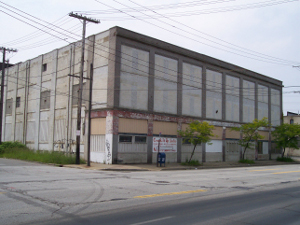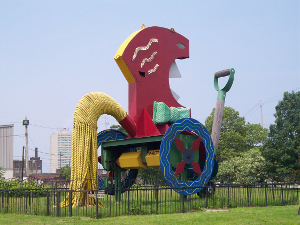 Cuyahoga County Archives
Cuyahoga County Archives
Those of you who have followed our reports for several years may remember our story of finding ancestors in some early Cleveland city directories. These crumbling directories are housed in the Cuyahoga County Archives, a pitiful substitute for a research facility. The Archives building is a poorly maintained 1890s house which has had storage facilities added to the back. Evidently the County government just does not regard the care and use of historic documents as an economic priority. Not only is the facility underfunded, but the staff just doesn't seem to care, pointing fingers at one another so as not to be interrupted from reading their magazines or calculating their sick leave. Evidently what management there is does not include a competent professional archivist. We took a photo of one of the bookshelves to share. We have made a resolution to work diligently everywhere else to find Ohio data, because we don't ever want to return to this building again! More to the point, the people of Cuyahoga County should donate their material to another facility where they will be properly managed. This will save the County money and perhaps save the documents as well.
 Cuyahoga County Archives
Cuyahoga County Archives
We set off this morning for on-scene investigations of some of the places we had found in various family records. First stop was the Knollwood Cemetery. After patiently waiting because the staff members did not have the key to the building and the boss had to drive in from Akron, we got a verbal list of six or eight sections of the cemetery that would have burials as far back as 1947 or earlier. With some uncanny luck (or perhaps a latent childhood memory) we picked the right section and located four Cadwell graves -- grandparents, aunt and uncle. Returning to the office, we learned that a cousin had just been buried in the same plot in January; the marker had not been set yet. That is one of the sad parts of doing family history -- you don't get a chance to visit all the relatives you find before they die. Last year we missed a 95-year old cousin in Kansas. But the young carry on, and now we have some more family contacts in Cleveland, and discovered another cousin living in Scottsdale, so we have more names on our list of folks to visit.
We stopped to see a street called Cadwell Street, and wondered how it was named; maybe some time we'll know. Not far away we saw the home on Greyton Road where the Cadwells finally settled; it was just a block from Nela Park, where Thomas Edison and General Electric developed and made light bulbs.
Earlier in the 1900s, Grandpa and Grandma Cadwell had lived in various homes on the east side of Cleveland, close to Case Institue of Technology (now Case Western Reserve University) and ERICO, where he worked. This part of the city became one of its worst slums by the 1960s; the Cadwell homes were located in the district where the Hough Riots took place. So we found two of the addresses non-existent, one replaced by a park, the other by a parking lot; and the third address was still a slum home. We didn't take our usual photograph because there were people sitting on the porch. We even saw the original home of ERICO on the corner of Carnegie and East 65th street. We were told that it's now a chop shop; ERICO moved out to the suburbs right after the riots.
 The old ERICO, East Cleveland
The old ERICO, East Cleveland
Driving up and down the streets of East Cleveland led us to an absolutely incredible observation. We had some hint as to what was coming because we noted that one block showed a lot of neighborhood pride -- houses painted and landscaped and gardened. But then, after a block of sad looking homes, we turned a corner and found ourselves looking at a brand new home, which we estimated to be 5,000 square feet with a three-car garage. It appeared to be right out of the pages of Architectural Digest. Across the street was a boarded up building. We were near East 65th street, and we saw block after block which contained a mixture of slum tenements and rich new luxury housing. This is the first time in our life that we have seen a counterexample to the real estate broker's mantra: Location, Location, Location.
We wish we could comment intelligently on the social phenomenon that is taking place, but we just don't know. Our guess is that the neighborhood remains predominantly Black, and that wealthy folks have been deliberately building their homes in an effort to improve the neighborhood. Cleveland is one of the cities that is fighting hard to recover its slums. It seems to us that the process takes lots of money,  "The Politician: A Toy"
and a great deal has to do with maintaining the existing buildings, tearing down those that are beyond repair, improving urban transportation, and -- perhaps most importantly -- getting people to move back into the city from the suburbs. The elegant new homes we saw in East Cleveland are evidence of clear personal commitment on the part of wealthy people.
"The Politician: A Toy"
and a great deal has to do with maintaining the existing buildings, tearing down those that are beyond repair, improving urban transportation, and -- perhaps most importantly -- getting people to move back into the city from the suburbs. The elegant new homes we saw in East Cleveland are evidence of clear personal commitment on the part of wealthy people.
While marveling at these contrasts in housing, we turned another corner and found, in a vacant yard at Chester and 66th Street, an amusing kinetic sculpture, entitled "The Politican: A Toy" (see photo.) It was created in the mid-1990s by artist Billie Lawless. The wrought iron words topping the four sides of the fence are: READ MY HIPS CONTRADICTION IN AMERICA |-----AFFIRMATIVE FRICTION WELFARE STRAIT LAW & BORDERS ----- FAMILY SHALLOWS STERN LIMITS TRICKLE OVER ----- A THOUSAND POINTS OF SLIGHT BORE THE PEOPLE WATERBREAK
All this intense research (and the passing of the morning hours) made us hungry. Driving west on Detroit Avenue in Lakewood, we were taken by the name of a restaurant: The Winking Iguana. It's a nice sports-bar place located in the old Elks Club, where a four foot green iguana has a comfy glassed-in home in the corner of the dining room. He twists around, makes faces at the guests and enjoys a vegetarian diet. Oh, yes, and we thought the food was pretty good, too.